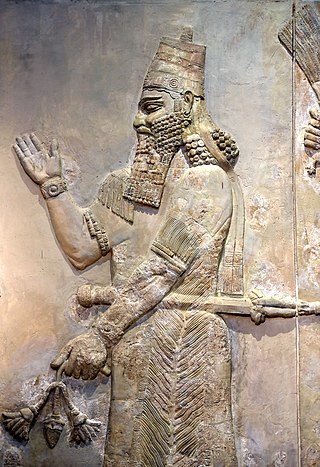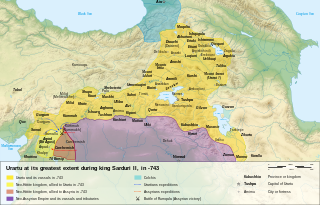
Shalmaneser III was king of the Neo-Assyrian Empire from the death of his father Ashurnasirpal II in 859 BC to his own death in 824 BC.
Tunna, also Dunna or Atuna, was an ancient Anatolian city. In classical antiquity Tunna was known as Tynna. Today it is known as Porsuk Hüyük or Zeyve Höyük.

Sargon II was the king of the Neo-Assyrian Empire from 722 BC to his death in battle in 705. Probably the son of Tiglath-Pileser III, Sargon is generally believed to have become king after overthrowing Shalmaneser V, probably his brother. He is typically considered the founder of a new dynastic line, the Sargonid dynasty.

Arame or Aramu was the first known king of Urartu.

Tabal was a Luwian speaking Neo-Hittite kingdom of South Central Anatolia during the Iron Age. According to archaeologist Kurt Bittel, references to Tabal first appeared after the collapse of the Hittite Empire. Tabal was likely an exonym applied by the Assyrians to Cappadocia. While its native name is uncertain, it is possible that it was called Sura, as mentioned in the records of Yariri, ruler of Carchemish.
Rusa I was a King of Urartu. He succeeded his father, king Sarduri II. His name is sometimes transliterated as Rusas or Rusha. He was known to Assyrians as Ursa and possibly Urzana. His birth name may have been Uedipri.
Nairi was the Akkadian name for a region inhabited by a particular group of tribal principalities in the Armenian Highlands, approximately spanning the area between modern Diyabakır and Lake Van and the region west of Lake Urmia. Nairi has sometimes been equated with Nihriya, known from Mesopotamian, Hittite, and Urartian sources. However, its co-occurrence with Nihriya within a single text may argue against this.
Lutipri was the father of the Urartian king Sarduri I.
Arzashkun or Arṣashkun was the capital of the early kingdom of Urartu in the 9th century BC, before Sarduri I moved it to Tushpa in 832 BC. Arzashkun had double walls and towers, but was captured by Shalmaneser III in the 840s BC.
Pitru was an ancient town off the Sajur, a western tributary of the Euphrates, approximately 12.5 miles south of ancient Carchemish. It is thought to be the Pethor mentioned in Numbers 22 as the home of Balaam, the non-Israelite prophet called upon by Balak to curse the Israelites of the Exodus.

Urartu is a geographical region and Iron Age kingdom also known as the Kingdom of Van, centered around Lake Van in the historic Armenian Highlands. The kingdom rose to power in the mid-9th century BC, but went into gradual decline and was eventually conquered by the Iranian Medes in the early 6th century BC. Since its re-discovery in the 19th century, Urartu, which is commonly believed to have been at least partially Armenian-speaking, has played a significant role in Armenian nationalism.

This article is an overview of the kings of the United Kingdom of Israel as well as those of its successor states and classical period kingdoms ruled by the Hasmonean dynasty and Herodian dynasty.

The Kurkh Monoliths are two Assyrian stelae that contain a description of the reigns of Ashurnasirpal II and his son Shalmaneser III. The Monoliths were discovered in 1861 by a British archaeologist John George Taylor, who was the British Consul-General stationed in the Ottoman Eyalet of Kurdistan, in a town called Kurkh, which is now known as Üçtepe, in the district of Bismil, in the province of Diyarbakir of Turkey. Both stelae were donated by Taylor to the British Museum in 1863.

Kummuh was an Iron Age Neo-Hittite kingdom located on the west bank of the Upper Euphrates within the eastern loop of the river between Melid and Carchemish. Assyrian sources refer to both the land and its capital city by the same name. The city is identified with the classical-period Samosata, which has now been flooded under the waters of a newly built dam. Urartian sources refer to it as Kummaha. The name is also attested in at least one local royal inscription dating to the 8th century BCE. Other places that are mentioned in historical sources as lying within Kummuh are lands of Kištan and Halpi, and cities of Wita, Halpa, Parala, Sukiti and Sarita(?). Kummuh bordered the kingdoms of Melid to the north, Gurgum to the west and Carchemish to the south, while to the east it faced Assyria and later Urartu.
Tell Aran is a Kurdish-majority town in northern Syria, administratively part of the al-Safira District of the Aleppo Governorate, located southeast of Aleppo close to Sabkhat al-Jabbul. Nearby localities include Tell Hasil, al-Nayrab and Tell Shughayb to the northwest and al-Safira to the southeast. According to the Syria Central Bureau of Statistics (CBS), Tell Aran had a population of 17,767 in the 2004 census. The town is famous for its grapes, vineyards and gardens. The number of residents of Talaar has exceeded 60,000, especially after the large numbers of people displaced from the city of Aleppo to it due to the bloody war in Syria. The affairs of the town of Talaran are managed through its municipality, which is elected by members of the Baath Party. Muhammad Shadi Murad is currently heading the municipality of Talaran, succeeding Mr. Haitham Hamam.

Luhuti, Lukhuti or Lu'ash, was an Iron Age Syro-Hittite Aramean region during the early 1st millennium BC located in northern Syria, in an area that used to be called Nuhašše.

Bit Agusi or Bit Agushi was an ancient Aramaean Syro-Hittite state, established by Gusi of Yakhan at the beginning of the 9th century BC. It had included the cities of Arpad, Nampigi (Nampigu) and later on Aleppo Arpad was the capital of the state-kingdom. Bit Agusi stretched from the A'zaz area in the north to Hamath in the south.
"Turtanu" or "Turtan" is an Akkadian word/title meaning 'commander in chief' or 'prime minister'. In Assyria, the Turtanu ranked next to the king.

Gurgum was a Neo-Hittite state in Anatolia, known from the 10th to the 7th century BC. Its name is given as Gurgum in Assyrian sources, while its native name seems to have been Kurkuma for the reason that the capital of Gurgum—Marqas in Assyrian sources —was named "the Kurkumaean city" in local Hieroglyphic Luwian inscriptions.

The Sargonid dynasty was the final ruling dynasty of Assyria, ruling as kings of Assyria during the Neo-Assyrian Empire for just over a century from the ascent of Sargon II in 722 BC to the fall of Assyria in 609 BC. Although Assyria would ultimately fall during their rule, the Sargonid dynasty ruled the country during the apex of its power and Sargon II's three immediate successors Sennacherib, Esarhaddon and Ashurbanipal are generally regarded as three of the greatest Assyrian monarchs. Though the dynasty encompasses seven Assyrian kings, two vassal kings in Babylonia and numerous princes and princesses, the term Sargonids is sometimes used solely for Sennacherib, Esarhaddon and Ashurbanipal.








